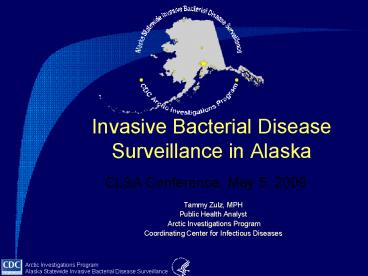Invasive Bacterial Disease Surveillance in Alaska - PowerPoint PPT Presentation
1 / 32
Title:
Invasive Bacterial Disease Surveillance in Alaska
Description:
Arctic Investigations Program. Alaska Statewide Invasive Bacterial Disease ... 1948 - USPHS established the Arctic Health Research Center as part of the Alaska ... – PowerPoint PPT presentation
Number of Views:125
Avg rating:3.0/5.0
Title: Invasive Bacterial Disease Surveillance in Alaska
1
Invasive Bacterial Disease Surveillance in Alaska
CLSA Conference, May 5, 2009
- Tammy Zulz, MPH
- Public Health Analyst
- Arctic Investigations Program
- Coordinating Center for Infectious Diseases
2
Summary
- Arctic Investigations Program (AIP) background
- Laboratory activities
- Surveillance program
- Global picture
3
AIP History
- 1948 - USPHS established the Arctic Health
Research Center as part of the Alaska Native
Hospital in Anchorage - Infectious diseases, particularly TB, were the
leading cause of death in Alaska - 1973 - Arctic Health Research Center closed,
staff transferred to CDC
4
Arctic Investigations Program
- Located on Alaska Native Tribal Health Consortium
campus - Staff includes employees from
- IHS
- Tribal organizations
- State of Alaska
- CDC
5
Arctic Investigations Program
- Epidemiology
- 5 physician epidemiologists
- 3 research nurses
- Public health analyst
- Laboratory
- Microbiology (3)
- Molecular Diagnostics (4)
- Computer Statistics
- Administration
6
AIP Mission
- To prevent infectious disease morbidity and
mortality in people of the Arctic and Subarctic - with special emphasis on diseases of high
incidence and concern among indigenous people
7
AIP Priorities
- Vaccine preventable diseases
- Antimicrobial resistance
- Eliminating health disparities
- Bioterrorism preparedness and response
- Emerging infectious diseases
8
Laboratory Activities
- Surveillance
- Streptococcus pneumonaie
- Haemophilus influenzae
- Neisseria meningitidis
- Groups A and B Streptococcus
- Helicobacter pylori
- MRSA
- Respiratory viruses
9
Laboratory Activities
- Building Laboratory Capacity
- Develop new assays
- PCR
- for detection and identification of pathogens
- for detection of virulence factors, mechanism of
resistance - PFGE for strain subtyping
- Bioterrorism response
- LRN level B/C
- BSL III
- B. anthracis, Y. pestis, F. tularensis, Brucella
sp
10
Laboratory Activities
- Support epidemiologic studies, outbreak
investigations and vaccine evaluation studies - H. influenzae type b eradication
- Pneumococcal carriage
- MRSA outbreak
- H. pylori reinfection
- Hepatitis B vaccine in infants/children
- Respiratory virus identification
11
Surveillance Organisms
- Streptococcus pneumoniae, 1986
- Haemophilus influenzae, 1980
- Neisseria meningitidis, 2000
- Groups A B Streptococcus, 2000
12
Statewide Invasive Bacterial Disease Surveillance
Participating Hospital/Clinic Laboratories
Barrow
Total population 640,000 AK Native 125,000
Kotzebue
Fairbanks
Nome
Palmer Anchorage
Bethel
Petersburg
Valdez
Soldotna
Juneau
Dillingham
Sitka
Kodiak
Ketchikan
13
Reportable Organisms
- Previously reportable
- Hi, Nm
- Reportable since January, 2007
- GAS, GBS, Sp
- Case reports to State DPH
- Isolates to CDC/AIP
14
Methods
- Labs submit sterile site isolates
- Confirmation and serotyping
- Antimicrobial susceptibility testing
- Clinical and demographic information collected
- Data entered and analyzed
- Annual audits for missing cases
- Yearly reports generated
15
Surveillance Cases ReportedAlaska, 2000-2008
16
Haemophilus influenzae type b
- Prevention
- Bacterial Polysaccharide Immune Globulin (BPIG)
- Polysaccharide (PRP) vaccine
- Conjugate Vaccines
- PRP-D
- HbOC (HibTITER)
- PRP-OMP (PedvaxHIB)
- HbOC,D,T,P (Tetramune)
- PRP-OMP, Hepb (ComVax)
17
Invasive Hib Disease, Children Aged lt5 Years,
Alaska,1980 - 2008
PRP-OMP
PRP-OMP/HbOC
DTwP-HbOC
PRP-OMP-Hep B
Singleton, et al. J Pediatr 2000 137313-20 and
CDC, unpublished
18
Remaining challenges..
- Can Hib be eliminated?
- Continued surveillance
- Improve serotyping QC
- Slide agglutination vs PCR
- Reduce Hib carriage
- Will we see replacement of Hib?
- Invasive disease caused by other serotypes or
nontypeables
19
H. influenzae a (Hia) Outbreak
- Last 6 months of 2003
- 5 cases of Hia
- Cases occurred in 3 infants
- 2 infants developed recurrent Hia
20
Hia Outside of Alaska
- Utah
- 5 cases of Hia in 1999
- Increased virulence
- Navajo
- A leading cause of pediatric bacterial meningitis
- International Circumpolar Surveillance
- 2000-2006 25 cases in children lt2 in N. Canada
21
Hia Unanswered Questions
- Reason for increase
- Changes in carriage?
- Changes in virulence?
- Chemoprophylaxis
- Yes for Hib, but for Hia?
- Factors
- Extent of colonization
- Evidence of secondary transmission
22
Prospective Study - HIRRI
- Investigate cases
- Invasive encapsulated H. influenzae
- Alaska children lt 10 y.o.
- Evaluate colonization among
- Close contacts
- Other members of the community
23
Objectives
- Describe cases
- Determine nature and extent of Hi colonization
- Determine risk factors for invasive Hi disease
- Characterize the strains of Hi using molecular
epidemiology - Prevention and control of disease
24
Streptococcus pneumoniae
- Prevention
- 23 valent pneumococcal polysaccharide vaccine
- Pneumovax
- Conjugate vaccine
- PCV7 (Prevnar) 4,6B,9V,14,18C 19A,23F
- Education
- Appropriate antibiotic use
25
Invasive Pneumococcal Disease in Alaska, 1996-2000
26
Invasive Pneumococcal Disease in Alaska, lt 2 Year
Olds, Pre-Vaccine, 19952000
73
79
Alaska Natives Non-Natives
27
Invasive Pneumococcal Disease in Alaska, lt 2 Year
Olds, Pre (19952000) and Post (20012005)
Vaccine Introduction
92
87
Alaska Natives Non-Natives
P lt 0.001, decline in vaccine type
Hennessy, et al, Vaccine, 2005
28
Invasive Pneumococcal Disease in Alaska, lt 2 Year
Olds, Pre (19952000) and Post (20012005)
Vaccine Introduction
Alaska Natives Non-Natives
P lt 0.001, decline in Vaccine type P 0.04
for increase in non-Vaccine type
29
Trends in Antibiotic Resistance Among Invasive
Pneumococcal Isolates Alaska, 1986 - 2007
Pen-NS non-susceptible, Pen-FR fully
resistant
30
International Circumpolar Surveillance
31
Objectives
- Establish an integrated network of hospital,
public health, and reference laboratories
throughout the Arctic - Monitor infectious disease rates trends
- Identify risk factors for disease
- Evaluate intervention options
- Monitor intervention effects
32
Acknowledgements
- Clinical laboratories in Alaska
- State of Alaska Public Health Laboratory
- State of Alaska Division of Epidemiology
- Arctic Investigations Program































